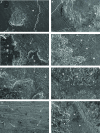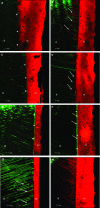Analysis of the bond interface between self-adhesive resin cement to eroded dentin in vitro
- PMID: 30475892
- PMCID: PMC6258132
- DOI: 10.1371/journal.pone.0208024
Analysis of the bond interface between self-adhesive resin cement to eroded dentin in vitro
Abstract
The purpose of this study was to evaluate the bonding interface between a self-adhesive resin cement to in vitro eroded dentin. Seventy-two third molars were used and divided into two groups: sound dentin and in vitro eroded dentin. The in vitro erosion was performed following a demineralization protocol, in which the specimens were immersed in a demineralizing solution for 2 minutes per cycle and remineralizing solution for 10 minutes per cycle for 9 days. Both groups were submitted to four dentin surface treatments: control group (without any treatment), 2% chlorhexidine, 20% polyacrylic acid, and 0.1 M EDTA (n = 9). Blocks of resin-based composite were bonded with RelyX U200 self-adhesive resin cement applied on the pretreated dentin surfaces. The teeth were sectioned into beams (1mm2) and submitted to microtensile bond strength testing to evaluate the bond strength of self-adhesive resin cement to dentin after 24 hours and 8 months of immersion in artificial saliva. Three specimens of each group were longitudinally cut and evaluated using confocal laser scanning microscopy to analyze the dentin/cement interface. Eroded dentin showed higher bond strength values when compared to sound dentin for the 2% chlorhexidine group (p = 0.03), 24 hours after adhesion. When considering eroded dentin, the 0.1M EDTA group showed higher bond strength values with a statistically significant difference only for the control group (p = 0.002). After 8 months of storage, the present results showed that there was no statistically significant difference between the two substrates for all experimental groups (p>0.05). Analysis of the microscopy confocal showed different types of treatments performed on dentin generally increased tags formation when compared to the control group. The eroded dentin showed a significant increase in density and depth of resinous tags when compared to sound dentin. The storage of samples for 8 months seems to have not caused significant degradation of the adhesive interface.
Conflict of interest statement
The authors have declared that no competing interests exist.
Figures





Similar articles
-
Bond strength and interfacial micromorphology of etch-and-rinse and self-adhesive resin cements to dentin.J Prosthodont. 2012 Feb;21(2):101-11. doi: 10.1111/j.1532-849X.2011.00794.x. Epub 2011 Nov 1. J Prosthodont. 2012. PMID: 22044733
-
Effect of temporary cements on the microtensile bond strength of self-etching and self-adhesive resin cement.Acta Odontol Scand. 2014 Nov;72(8):762-9. doi: 10.3109/00016357.2014.903518. Epub 2014 May 19. Acta Odontol Scand. 2014. PMID: 24837710
-
Effect of storage times and mechanical load cycling on dentin bond strength of conventional and self-adhesive resin luting cements.J Prosthet Dent. 2014 May;111(5):404-10. doi: 10.1016/j.prosdent.2013.07.016. Epub 2013 Dec 17. J Prosthet Dent. 2014. PMID: 24355507
-
Effect of interim cement application on bond strength between resin cements and dentin: Immediate and delayed dentin sealing.J Prosthet Dent. 2017 Jun;117(6):792-798. doi: 10.1016/j.prosdent.2016.09.015. Epub 2016 Nov 12. J Prosthet Dent. 2017. PMID: 27847158
-
Analysis of laboratory adhesion studies in eroded enamel and dentin: a scoping review.Biomater Investig Dent. 2021 Feb 15;8(1):24-38. doi: 10.1080/26415275.2021.1884558. Biomater Investig Dent. 2021. PMID: 33629074 Free PMC article.
Cited by
-
Effects of different concentrations of sodium hypochlorite on dentine adhesion and the recovery application of sodium erythorbate.Zhong Nan Da Xue Xue Bao Yi Xue Ban. 2022 Feb 28;47(2):226-237. doi: 10.11817/j.issn.1672-7347.2022.200994. Zhong Nan Da Xue Xue Bao Yi Xue Ban. 2022. PMID: 35545413 Free PMC article. Chinese, English.
-
Investigating a Commercial Functional Adhesive with 12-MDPB and Reactive Filler to Strengthen the Adhesive Interface in Eroded Dentin.Polymers (Basel). 2021 Oct 15;13(20):3562. doi: 10.3390/polym13203562. Polymers (Basel). 2021. PMID: 34685320 Free PMC article.
-
In vitro evaluation of antimicrobial photodynamic therapy with photosensitizers and calcium hydroxide on bond strength, chemical composition, and sealing of glass-fiber posts to root dentin.Lasers Med Sci. 2025 Jan 28;40(1):51. doi: 10.1007/s10103-025-04302-4. Lasers Med Sci. 2025. PMID: 39873812 Free PMC article.
-
Effectiveness of dentin pre-treatment on bond strength of two self-adhesive resin cements compared to an etch-and-rinse system: an in vitro study.PeerJ. 2021 Oct 26;9:e11736. doi: 10.7717/peerj.11736. eCollection 2021. PeerJ. 2021. PMID: 34754615 Free PMC article.
-
Biomimetic Remineralization Strategies for Dentin Bond Stability-Systematic Review and Network Meta-Analysis.Int J Mol Sci. 2025 Apr 8;26(8):3488. doi: 10.3390/ijms26083488. Int J Mol Sci. 2025. PMID: 40331951 Free PMC article.
References
-
- Scaramucci T, Hara AT, Zero DT, Ferreira SS, Aoki IV, Sobral MA. Development of an orange juice surrogate for the study of dental erosion. Braz Dent J. 2011; 22(6): 473–478. - PubMed
-
- Barbosa CS, Kato MT, Buzalaf MA. Effect of supplementation of soft drinks tea extract on their erosive potential against dentine. Aust Dent J. 2011; 56(3): 317–321. 10.1111/j.1834-7819.2011.01338.x - DOI - PubMed
-
- Hara AT, Livengood SV, Lippert F, Eckert GJ, Ungar PS. Dental surface texture characterization based on erosive tooth wear processes J Dent Res. 2016; 95(5): 537–542. 10.1177/0022034516629941 - DOI - PubMed
-
- Moretto MJ, Magalhães AC, Sassaki KT, Delbem AC, Martinhon CC. Effect of different fluoride concentrations of experimental dentifrices on enamel erosion and abrasion. Caries Res. 2010; 44(2): 135–140. 10.1159/000302902 - DOI - PubMed
-
- Buzalaf MA, Hannas AR, Kato MT. Saliva and dental erosion. J Appl Oral Sci. 2012; 20(5): 493–502. 10.1590/S1678-77572012000500001 - DOI - PMC - PubMed
Publication types
MeSH terms
Substances
LinkOut - more resources
Full Text Sources
Other Literature Sources

